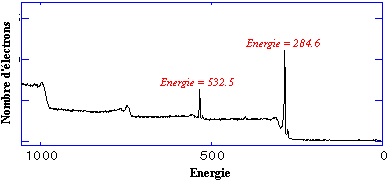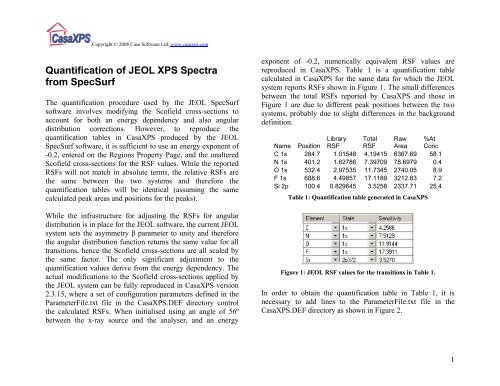
To browse this data in an interactive way an app is under development and we working on opening up this data to the public.
#Xps peak data code#
The worldwide first all-electron high-throughput density functional theory calculations with the FLAPW method using the FLEUR code were performed within this project on the Forschungszentrum Ju ̈lich GmbH computing infrastructure.

Through this core-level shift data the X-ray photoelectron spectra of beryllides (Be-W, Be-Ti, Be-Ta) relevant for the plasma-facing components of a nuclear-fusion reactor like for the International Thermonuclear Experimental Reactor (ITER) can now be chemically interpreted. The resulting core- level shifts data allows for the interpretation of X-ray photoelectron spectra for all these materials and mixtures of these. These workflows are deployed within a material screening project on most known binary metals. For automation the FLEUR program was connected to the AiiDA framework and workflows were implemented to calculate a range of material properties. The challenge lies in the automation advancement and connection to different tools in order to provide a low cost solution for a broader set of materials in order to be useful to a broader audience.įor the calculation of spectral properties the open source all-electron DFT program, FLEUR implementing the powerful, highly accurate Linearized Augmented Plane Wave method (FLAPW) was chosen. The underlying models and methods applied are known. In this project we advance an ab initio data-driven solution for the basic chemical material characterization with X-ray photoemission spectroscopy. Reference data for core-level shifts and binding energies the literature like collected in the NIST XPS database is only available for a few materials. The detailed evaluation of multi-phase high-resolution XPS spectra often challenging in practice. XPS is a well known and widely applied technique in research and industry. For the determination of the chemical phase composition of a sample, XPS or formally known as electron spectroscopy for chemical analysis (ESCA) is the method of choice. Insight into the elemental composition can be provided by different scattering or scanning probes, also through X-ray photoemission spectroscopy (XPS). For the identification of the crystal structure and large solid periodic phases X-ray diffraction (XRD) is the state of the art technique. The same is true when studying surface and material changes under external influences. In material research and quality assessment sample characterization and chemical phase identification play an essential role.
#Xps peak data how to#
how to plot arrot plot from magnetic data(m h loop) via origin software youtu.be 7 vq2amnwki 2.Simulation of XPS spectra Project overview: this video gives you the idea about the baseline correction & multipeak fitting (using lorentzian function) of xps data. there are xps peak fitting and baseline correction using origin pro. the simplest but effective way of multiple peaks fitting of xps, raman, photoluminesence spectroscopic data graph. this video shows multiple peak xps peak fitting using origin software. this video shows how to this tutorial video explains how to do #multiplepeakfitting using #origin #peakandbaseline tool. this tutorial is for all who are analyzing their xps data for writing a thesis or presentation or publishing. deconvolutepeaksinorigin #multiplepeaksfittinginorigin #sayphysics 0:00 how to deconvolute multi peaks using origin 3:27 peak xps #baseline #correction and #curve #fitting #nanoencryption. basic steps for deconvolution of a multi peak curve in origin. Two peak fitting in xps spectra of sn 3d. there are several ways to do it but i found this is the best way to do it quickly and easily. Multiple peaks fitting of xps, raman, pl spectroscopy │curve fitting using origin.

in the dialog, select the input data and the peak function for performing the fit. select analysis: peak and baseline: multiple peak fit from the main menu. The multiple peak fit tool provides an interactive and easy way to pick multiple peaks in a graph and then fit them with a peak function. for the specific example it shows, the lessons it leaves are grossly. when you truly are fitting xps spectra, please do not follow the fundamental methods of the tutorial. in this regard, i first have a hard rebuke to make. the fitting is on xps spectra, a topic i know well. My final observations are from a review of the demo video. Inscilab Explanation Multiple Peaks Fitting Of Xps


 0 kommentar(er)
0 kommentar(er)
